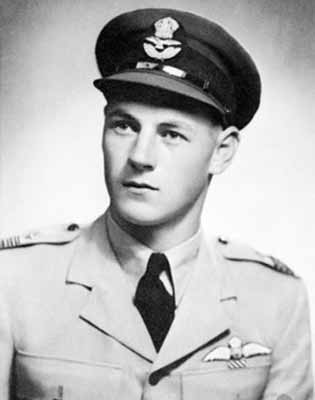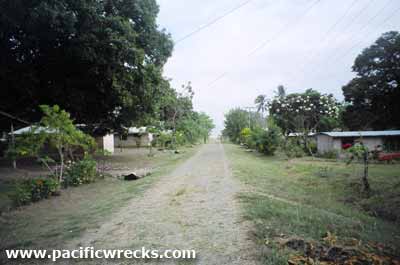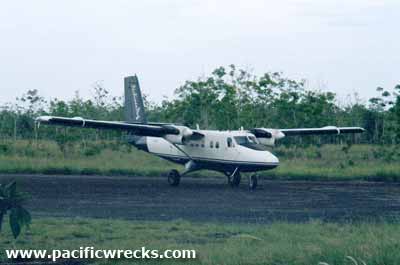My main reason for visiting Goodenough
Island in November 2004 was to research a forthcoming book
Wings of Destiny: Wing Commander Charles Learmonth, DFC and Bar and the Air War in New Guinea. Charles Learmonth
was the C.O of No.22 Squadron based at Vivigani Airfield on Goodenough
Island. He was later appointed C.O. of No. 14 Squadron at Pearce
Airfield but was killed January 6, 1944, when his Beaufort crashed
into the sea off Perth. However, it was also suggested to me by dive boat operator Rod
Pearce,
that I take the opportunity to search for a Beaufort from No. 100 Squadron that crashed southeast of Vivigani
Airfield.
Milne Bay
As it happened, my arrival at Alotau coincided
with a schedule change, and the ferry had already sailed the day before.
I stayed the next two days at the Alotau International Hotel, which
provides excellent accommodation, meals and facilities. The lush and
scenic Milne Bay area is well worth exploring, and the WWII sites can
be easily seen in a day.
With
the aid of the Milne Bay Tourist Office, I found a small wooden cargo
boat, MV Yayata. The crew looked like pirates, but
turned out to be friendly companions, as were the twenty or so passengers.
The boat was surprisingly seaworthy and the voyage took eighteen
hours, calling in at various settlements and missions on Normanby
Is. and Fergusson Is. On the boat, I was lucky to meet Francis Maika,
who claimed to know the location of a crashed plane on Goodenough
Island. He recalled that as a boy, he used to fish off the wing.
Apparently no one outside the island had visited the crash site
since 1944.
Goodenough Island
Getting to Goodenough Island can be something
of an adventure. There are connections on Air Niugini or Airlines
PNG from Port Moresby to Milne
Bay. After that it takes some planning, as there is only the
weekly ferry, Attolls Queen, and schedules are subject to
change. This modern comfortable ferryboat takes about seven hours
to reach Goodenough Island.
We eventually tied up at the tiny settlement of
Bolubolu, the administrative centre for Goodenough Is. The boat was
met by most of the island’s
population, and I was escorted up the main footpath to the guest
house, where a meal of taro, yam and rice was later provided. The
generator runs from 6pm to 10pm, after which, it’s into the
mosquito net.
Goodenough Island is only 30 kilometers across, but extremely mountainous,
with peaks up to 8,000 feet. I was told it takes two days to climb
up to the highest peak. The climate is hot and humid most of the
time and it is advisable to carry bottled water. The locals are friendly
and hospitable, and speak excellent English, but little or no Pidgin.
There is hardly any crime on the island, and only
one policeman. Vehicles are virtually non-existent, apart from a
battered old ute, which is used mainly for transport to the airfield.
Communications are difficult, as mail is irregular, and there are
only two phones on the island, one for the police and one for the
District Office, which is not attended on a regular basis. There
are two small stores at Bolubolu.
Beaufort Wreckage Discovery
The day after arrival, Francis and I
hired a dinghy, and with Johnny Biligote at the helm, motored two
miles up the coast to a small inlet and creek. This led us into a
mangrove swamp, and after squelching through thick glutinous mud
for about two hundred meters, we found the aircraft wreckage. Most
of it was submerged in the mud except for a propeller blade, part
of a wing centre section, and several small shreds of debris. There
were no identifying marks on any of the wreckage, and some strenuous
digging would be required to find any.
Nevertheless,
the centre wing section appears to be from a Beaufort aircraft. If
this is the case, it could be No.100 Squadron Beaufort
A9-480, which
crashed two miles south-east of Vivigani airstrip on 5th March 1944.
The crew consisted of F/O A.P. Potts (pilot), F/O Easton (WAG), F/Sgt,
Wiblin (Nav), and F/Sgt. Hammersley (WAG). Cinema operator Cpl. Duggan
was on board as a supernumerary. All five personnel were killed.
They were buried in the American Cemetery on Goodenough Is. but were
later re-interred in Bomana War cemetery, Port Moresby.
The cause of the accident was listed as unknown, but the Court of
Enquiry considered that the pilot may have lost orientation after
a night take-off into haze. However, the pilot was well experienced
for a wartime pilot, with 1655 hours flying time. Also the propeller
blade condition suggests that the engine was not under power at impact.
More Crash Sites
The
locals suggested a visit to another site, near the airfield. This site
was approached through a lightly treed area between the airstrip and
the coast, and involved a tricky log crossing, and a track leading
past the rare Amorphophallus (corpse
flower),
with its malodorous stench. At least three derelict Beauforts were
seen, and in one case, a tree had grown up through the wreckage.
These aircraft were abandoned, rather than crashed, and have since
been visited by several aircraft enthusiasts.
Vivigani Airstrip
We also inspected the Vivigani airstrip, situated on the lush green
coastal plain. The 6,000 feet bitumen runway is still in use, and
only slightly weed strewn. The many aircraft revetments are clearly
visible, especially from the air. Various aircraft components can
still be found scattered around. Towards the mountains, a fast running
creek gushes over a waterfall and into a rock pool, which was used
by the WWII crews for recreation and washing.
On the drive back to Bolubolu, we stopped at the school, which for
years used an aircraft wing as its sign. This wing is now in the
playground, and the undersurface appears similar to the outer wing
panel of the Boston. There was a strange faded yellow chevron marking,
but this could have been painted on by the school.
Farewell
On
my last day at Goodenough, the locals drove me out to Vivigani Airfield
to await the Airlines PNG Twin Otter. This weekly flight is invariably
delayed due to weather or serviceability, and this day the plane
was four hours late. The airfield has virtually no facilities, and
the time was spent further exploring the area. Then with no warning,
the Twin Otter swept in low from the north and we were soon on our
way to an ice cold beer in Alotau.
|













